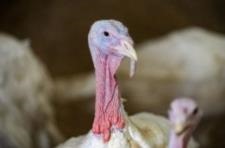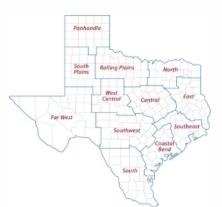Consumers can expect higher prices and fewer options for whole turkeys leading into this Thanksgiving, according to a Texas A&M AgriLife Extension Service expert.
David Anderson, Ph.D., AgriLife Extension livestock economist, Bryan-College Station, said turkey production was down 5% compared to last year, but prices have risen significantly. Fewer turkeys combined with higher food supply chain and logistical costs like feed, fuel and labor have pushed prices upward.

Turkey numbers are at their lowest point since 2015. (Texas A&M AgriLife photo by Laura McKenzie)
The national wholesale average for whole hens is $1.35 per pound compared to $1.14 per pound this time last year, Anderson said. The five-year average per-pound price is $1.06 for those turkeys.
Wholesale boneless, skinless turkey breasts, which mostly end up in retail delicatessens and sandwich shops, were up to $3.45 per pound compared to $1.80 per pound last year with a five-year average of $2.74 per pound.
Anderson said both turkey numbers and pounds produced are at the lowest point since 2015, a response to slipping demand.
“This has a lot to do with the fact they are producing fewer turkeys,” he said. “Other factors are a part of that, but this is more to do with years of per-capita consumption dipping and longer-term demand-side issues for the turkey industry.”
Holiday demand dips for whole turkeys
Anderson said marketing and economic changes for turkey have been driven by consumer choices around the holidays, which has historically driven the whole bird market.

Consumers should expect to see higher prices and fewer options for holiday turkeys this year due to reduced production. (Stock photo)
The pandemic clearly impacted the number of holiday gatherings last year, which did not help the industry, but over the past several years, consumers have gone with other meat options, especially for traditional get-together style holiday lunches and dinners beyond Thanksgiving.
“We typically think of Thanksgiving and Christmas when we talk about whole turkeys, but a growing number of consumers have chosen other options like prime rib or brisket or an entirely different menu that used to represent that second bird,” he said. “It doesn’t take a large percentage of that among 330 million consumers to be a big deal.”
Anderson said the other big part of turkey consumption – as deli meats – has grown slightly over recent years but is being outpaced by other grocery store and restaurant offerings.
Fewer options for centerpiece turkeys
Anderson said prices for pork, beef and chicken are also up, but that other factors from bottlenecks to feed prices and higher demand are driving those increases. Aside from hitting consumers in the pocket, lower supplies of whole birds could mean finding the prototypical centerpiece turkeys could be more difficult this Thanksgiving.
Lower supplies and higher costs could also mean individual grocery stores may not offer feature specials on whole birds that are typically used to attract shoppers in hopes they fill their shopping carts with other related items.
“They may not be able to find certain size birds they are used to, or it may be frozen rather than fresh,” he said. “This year, buying a turkey may require being more flexible according to what is available.”
AgriLife Extension district reporters compiled the following summaries:
CENTRAL
Rainfall events occurred throughout the week and limited fieldwork. Temperatures were cooling. Some areas received more than 5 inches. There was standing water in areas. What cotton remained to harvest looked poor under wet conditions. Newly emerged oat and wheat fields looked excellent. Pastures were greening up again. Harvested corn, sorghum and cotton fields were becoming weedy. Livestock were grazing greening stubbles. Farm ponds were filling. Wheat plantings should ramp up once fields dry enough, but fertilizer and fuel prices and nitrogen fertilizer availability may impact producer decisions and ultimately acres. Most counties reported good livestock conditions.

A map of the 12 Texas A&M AgriLife Extension districts.
ROLLING PLAINS
A cold front delivered cooler temperatures and some rain. Hardeman County reported trace amounts of rainfall up to 1 inch while Palo Pinto County reported 2 inches and Wise County reported 2.5-3.5 inches of rain. The rain was needed for wheat planting. Wheat had emerged in some locations, but some counties were reporting poor wheat emergence and conditions. Emerged wheat that received good rains was recovering from dry conditions well. More wheat planting was expected when soil conditions allow. Irrigated cotton looked good in all areas, but dryland fields looked poor, and some farmers were starting to harvest. Rain was expected to hurt cotton grades with average to above-average yields being reported. Pastures perked up following the rains, and producers were expecting some fresh growth up to frost. Bottomland pastures looked especially good, and producers were turning out cattle for grazing. Cows and calves looked good. Most calves were weaned.
COASTAL BEND
Most areas of the district reported heavy rains, which resulted in deep soil moisture but halted fieldwork. Ponds were full, with some flooding but little damage reported. Cotton was mostly baled up. Cotton stalk destruction was halted due to wet conditions, and there were concerns about green-up in fields that had not been tilled or sprayed. Second crop rice headed out and neared harvest. Some winter pastures were planted and responded well to moisture. Many wildlife plots were also planted. Rangeland and pasture conditions improved with adequate soil moisture. However, grass growth was limited by cooler temperatures and shorter day length. Some early pecan harvest began. Livestock remained in good condition with steady to higher prices at market.
EAST
Conditions were drying up in most of the region, but Cherokee County reported that recent rainfall improved conditions. Harrison County reported a growing fire risk. Pasture and rangeland conditions were fair to good. Subsoil conditions were short to very short, and topsoil conditions were short. Producers were wrapping up their final cuttings of hay. Fall gardens were doing well with proper supplemental watering. Horseflies were a major nuisance.
SOUTH PLAINS
Dry conditions continued across the district. The pumpkin harvest finished up for the year for Floyd County. Cotton farmers were defoliating across the district, and harvest will be in full swing very soon. Sorghum harvest continued with good yields reported. Cattle were in good condition.
PANHANDLE
Soil moisture levels were short to adequate for nearly all areas. Overall rangeland and pasture conditions were poor to fair, and crops were in fair to good condition. Producers were busy with silage and corn harvests and planting wheat and preparing for cotton harvest. Silage cutting was close to completion with decent yields this year. Corn harvest was underway with some above-average yields reported. Sorghum harvest was going well especially on the seed side. Dryland sorghum did well this year with some great yields reported. Winter wheat planting was underway with many acres in and emerged. Early planted fields were starting to be irrigated in anticipation of some grazing. Cotton was close to stripping with many of the harvest aides already applied. Most warm-season forages on rangelands and pastures were now dormant. Precipitation was needed for fall and winter grazing.
NORTH
Soil moisture remained very short to short for some counties and adequate to surplus for other counties. Rainfall amounts ranged from 1-3 inches around the district. The moisture was needed but limited fieldwork. Temperatures ranged from lows in the 50s to highs in the 80s. Pasture and rangeland conditions were very poor to good. Summer grasses had mostly shut down in drier areas. Winter wheat was planted but had not yet emerged. Livestock were in good condition. Winter rye and other cool-season forages were emerging.
FAR WEST
Overnight temperatures were in the low 50s and daytime highs were still into the high 80s in some areas. No precipitation was reported over the last few weeks, which has hurt rangeland conditions. Bacterial blight was still an issue in crops. Ranchers continued with fall shipping season.
WEST CENTRAL
The weather started to cool, and the area received a good rain, 1-3 inches, that should jump start recently planted small grains. More producers applied fertilizer and planted small grains. Planted wheat was emerging. Some pecans were harvested, but some needed to open a bit more. A lot of dryland cotton was sprayed with defoliant to prepare for harvest. Pastures were in good shape. Livestock remained in good condition with abundant forage.
SOUTHEAST
Producers were beginning to plant winter forages, and oats made up a majority of acres. There was very little rain lately, though Walker County reported decent rains and San Jacinto reported heavy rains. Most hay fields had been cut and baled, but some producers were trying to get a final cutting before temperatures stopped growth. Army worms were a problem for some producers looking to get their last cutting. Cool-season forages were being established. Rice harvest had finished up for the most part. Livestock were in good condition. Rangeland and pastures were poor to excellent with fair ratings being most common. Soil moisture levels were adequate to surplus.
SOUTHWEST
Cooler temperatures and rainfall were reported across the district. Caldwell County reported up to 8 inches of rain with some flood damage. Recent moisture improved pasture conditions. Small-grains land preparation and planting continued as conditions allowed. Livestock were in fair to good condition, and markets were steady to higher. Wildlife were in good condition.
SOUTH
Weather was mild with short to adequate soil moisture levels. Cooler temperatures were reported in some areas, and scattered rains were reported in several counties. Amounts ranged from 0.5 of an inch to 3.5 inches. Wheat and oat fields were being planted, while cotton and peanut harvests continued. Cotton and sesame harvests were complete in some areas. Cotton and grain prices were very good for producers. Growers continued to prepare for strawberry planting. Cool-season vegetables were being planted. Pasture and rangeland conditions were poor to excellent. Ranchers were providing supplemental feed for their herds and wildlife. Hay prices were $50-$65 per round bale. Pastures greened up in areas that received good rains. Disking and other fieldwork continued. Beef cattle producers were busy marketing calves, and sale barns were reporting above-average volumes with steady to slightly lower prices on all classes. Citrus trees and sugarcane were being irrigated. Citrus trees were showing some fruit, but many trees were not showing signs of new growth.
Source : tamu.edu